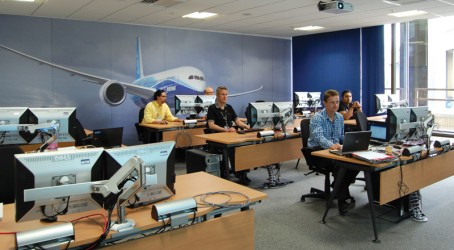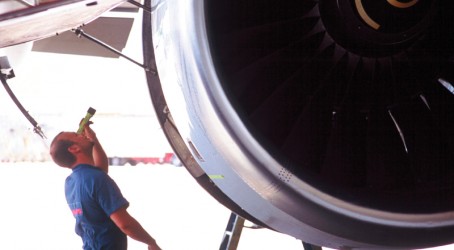The wait is nearly over. In just a few weeks’ time, British Airways will take delivery of its first Boeing 787 Dreamliner, with excitement building to a crescendo in the organisation.
The 787 will be a very different aircraft from any other in BA’s fleet. Firstly, it has a far higher percentage of composites than has been seen before, making up 50% of the primary structure including fuselage and wing. It is also fitted with a new engine – the Trent 1000 from Rolls-Royce – which fulfils Boeing’s demand for a “more electric” aircraft by offering a bleed-less design with power take-off from the intermediate-pressure spool instead of the high-pressure spool as found in other Trent variants. And the 787 is crammed full of other custom-made components and systems, all of which have to be maintained in an appropriate manner to ensure the highest levels of safety and operational reliability.
That’s where BA’s engineering division comes into its own. For the past year or so, it has been busy preparing technical staff for the arrival of the 787 by developing training courses to take place in a classroom built to Boeing specifications. Within this facility, which is located in Hatton Cross on the fringes of Heathrow airport, maintenance teams have been getting to grips with the new aircraft through the use of virtual technology that simulates many aspects of the aircraft’s mechanical and avionics systems behaviour. This has meant the teams have been able to explore the workings of the 787, familiarising themselves with the aircraft well in advance of its physical arrival.
“The 787 training facility is unlike any other in the world,” says David Smyth, manager of the engineering learning academy in BA’s training services division. “We have worked closely with Boeing to ensure that it offers the best learning environment, blending the latest visualisation technologies with our own extensive, first-hand experience in aircraft maintenance. Those who have already been through the training cannot wait for the first plane to arrive, so they can begin practical application.”
The 787 facility comprises 16 seats, each surrounded by a bank of screens. One screen offers a fantastically realistic simulation of a flight deck, allowing high-powered zooming right down to close-ups of individual switches and displays. Learners are set what are known as line-operated scenarios – whereby they are given a mechanical or avionics fault on the aircraft related to the central computer function that they are required to fix. “It’s a completely realistic environment,” says Smyth. “The only thing that they cannot do is reach out and grab one of the aircraft control sticks. It is the ideal way to learn about the flight-deck environment, where mistakes can be made without any safety implications.”
An adjacent screen at each seat shows an elevated view of a stationary 787, giving the learner 360-degree visibility and full movement around the outside of the aircraft. Again, a line-operated scenario can be issued, requiring the learner to zoom into an individual panel, open it, and move around internally. A faulty component can then identified and, in conjunction with a fully electronic maintenance manual, fixed as required. Then it is back to the flight desk to test the change and clear the fault.
“One of the scenarios involves a auxiliary power unit door actuator failure,” says Nathan Vass, one of the instructors at the training facility. “Learners assess the problem initially from the flight deck, finding the fault and troubleshooting using the electronic maintenance manual. Then they use the visualisation software to repair or change the actuator while making sure all the other associated systems are safely isolated. Then it’s about testing and passing the fault before being ready to dispatch the plane.”
So far, BA has run technical courses for its own maintenance staff who want to qualify in B1/B2 maintenance theory for equipment such as the Trent 1000. It has also carried out general familiarisation courses for executive staff who are required to have a decent knowledge of the 787’s workings.
But Smyth says that BA wants to use the facility to expand its training capabilities to help other airlines that are bringing 787s into their fleets. BA’s engineering arm is the first approved training school in the world that can deliver B1/B2 training on a commercial basis. “With so many operators integrating 787s into their fleets in coming years, there will be a huge demand for associated training. We think there will be a capacity issue in aviation that will need supporting,” he says.
“Therefore, we have invested in our training infrastructure and in our people to ensure that we are well placed to take advantage of this commercial opportunity. We have already run training for BA staff, meaning that our external customers will benefit from mature courses.”
Indeed, the facility has already been used to train staff from the Civil Aviation Authority. And Smyth says that discussions are being held with several airlines who want to buy a range of training courses associated with the new aircraft.
“For this to be successful, we have to offer a premium learning experience,” he says. “This is not about sitting learners down and working through a series of boxes that must be ticked. It’s about ensuring that the training we provide is continually updated and refreshed, and that we invest in pre- and post-learning activities to ensure that participants get the most out of it.”
One way that content will evolve is through the development of a new learning management system within the organisation. This will see a greater emphasis on e-learning, offering what Smyth describes as a “more blended” style of course delivery. “Younger people do not learn in the same way as their older colleagues – they have not been taught by rote,” he says. “So remote learning will have a place. That’s something we are looking into.”
He also sees the potential for aerospace maintenance workers to learn through augmented reality, using visualisation techniques already being used in the automotive sector to develop new vehicles. “That’s something for the future that we are interested in,” he says.

BA kickstarts skills supply as demographic changes loom
As manager of the engineering learning academy in British Airways’ training services division, David Smyth has a natural interest in the aviation skills pipeline. And he worries that demographic changes could soon lead to chronic skills shortages.
“Skills got neglected by all businesses during the past 20 years, and we are finding a shortage of adequately trained people in their 30s. Skills provision has got better at school-leaver age, with many companies having woken up to the fact that they need to offer schemes such as apprenticeships to bring people through. But there is a gap among those who are a bit older.”
Indeed, BA is now offering an apprenticeship scheme after a 16-year gap. It has also formed a relationship with the University of South Wales, providing content for a BSc degree course in aircraft maintenance engineering. “The course was launched last year and the university had 65 students on its first intake. We are not obliged to take on those who come through it – it’s more about kickstarting a supply of young people into the industry. We all need these skills,” he says.
BA is also involved with the formation of the Heathrow Aviation Engineering University Technology Centre (UTC), based in Northwood, west London, which will educate students who want practical and technical skills provision. The UTC will take students aged 14-19, specialising in aviation engineering, and combining practical and academic studies.
